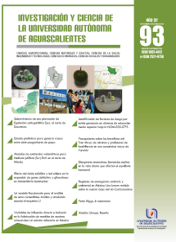Estudio preliminar para generar cruzas entre siete progenitores de papa
DOI:
https://doi.org/10.33064/iycuaa2024934753Palabras clave:
Solanum tuberosum, Floración, sistemas de apareamientoResumen
Los planes de cruzamiento son un prerrequisito para caracterizar variedades de papa que son utilizadas en programas de mejoramiento genético, producción de semilla, así como para generar, validar, aplicar y transferir tecnología. El objetivo principal del presente estudio fue realizar todos los cruzamientos entre siete progenitores, pero sólo 26 cruzas se realizaron y 12 de éstas produjeron fruto. Los mejores progenitores masculinos fueron Caesar, Fianna y Orquesta. La mejor cruza fue Atlantic x Cesar, seguida de Fianna x Cesar (147 y 135 semillas por fruto, respectivamente).
Descargas
Citas
• Almekinders, C. J. M., and Wiersema, S. G. (1991). Flowering and true seed production in potato (Solanum tuberosum L.) I. Effects of inflorescence position, nitrogen treatment and harvest date of berries. Potato Research 34:379-388. DOI: https://doi.org/10.1007/BF02360574
• Almekinders, C. J. M. (1991). Flowering and true seed production in potato (Solanum tuberosum L.) 2. Effects of stem density and pruning of lateral stems. Potato Research. 34:365-377. DOI: https://doi.org/10.1007/BF02360573
• Aksoy, E.; Demirel, U.; Bakhsh, A.; Zia, M.A. B.; Naeem, M.; Saeed, F.; Çalışkan, S. and Çalışkan, M. E. (2021). Recent advances in Potato (Solanum tuberosum L.) Breeding. In: Al-Khayri, J.M., Mohan J., S. and Johnsin, D.V. Ed. Advances in plant breeding strategies: vegetable crops. Volume 8: Bulbs, Roots and Tubers. (Pp. 409-488). Springer Nature Switzerland AG. DOI: https://doi.org/10.1007/978-3-030-66965-2_10
• Anisimov, B.V.; Simakov, E.A.; Zhevora, S.V. and Zebrin, S.N. (2021). Production of first and subsequent field generations/classes of original, elite, and reproduction potato seed: Potato breeding using true (botanic) seeds. In: Zhevora, S.V. and Anisimov, B.V. eds. Potato seed production. Pp. 49-60. Springer Nature, Switzerland. DOI: https://doi.org/10.1007/978-3-030-60762-3_5
• Bethke, P. C. and Jansky, S.H. (2021). Genetic and Environmental Factors Contributing to Reproductive Success and Failure in Potato. American Journal of Potato Research. 98:24–41. DOI: https://doi.org/10.1007/s12230-020-09810-3
• Bonierbale, M.W.; Amoros, W.R.; Salas, E. and De Jong, W. (2020). Potato breeding, In: Campos, H., Ortiz. O. (eds.). The potato crop. (pp. 163-217). Switzerland: Springer. DOI: https://doi.org/10.1007/978-3-030-28683-5_6
• Gopal, J. (1994). Flowering behavior, male sterility and berry setting in tetraploid Solanum tuberosum germplasm. Euphytica 72:133-142. DOI: https://doi.org/10.1007/BF00023782
• Gopal, J.; Kumar, V. and Luthra, S. K. (2008). Top-cross vs. poly-cross as alternative to test-cross for estimating the general combining ability in potato. Plant Breeding 127: 441-445. DOI: https://doi.org/10.1111/j.1439-0523.2008.01491.x
• Gopal, J. (2015). Challenges and way-forward in selection of superior parents, crosses and clones in potato breeding. Potato Res, 58:165-188. DOI: https://doi.org/10.1007/s11540-015-9292-6
• Golmirzaie, A. M. and Mendoza, H. A. (1985). Identification of parental lines for development of TPS population. American Potato Journal, 62: 427- 428.
• Grun, P. and Albertin, M.(1966).The inheritance and expression incompatibility in Solanum. Heredity, 21:131-138. DOI: https://doi.org/10.1038/hdy.1966.7
• Hanneman Jr., R. E. (1999). The reproductive biology of the potato and its implication for breeding. Potato Research, 42: 283- 312. DOI: https://doi.org/10.1007/BF02357859
• Howard, H. W. (1970). Genetics of the Potato Solanum tuberosum L., 125 p. London, Logos Press.
• Mendoza, H.A. and Haynes, F.L. (1974). Genetic basis of heterosis in the autotetraploid potato. Theoretical and Applied Genetics. 45:21-25. DOI: https://doi.org/10.1007/BF00281169
• Mendoza, H. A. (1983). Selection of uniform progenies to use TPS in commercial potato production, In: Report 16 of Planning Conference on Present and Future Strategies for Potato Breeding and Improvement. pp:87-97. Lima, Peru, International Potato Center (CIP).
• Molina, J. de D.; Santos, B.M. y Aguilar, B. L. (2004). Guía MIP en el cultivo de la papa. Instituto Nicaragüense de Tecnología Agropecuaria. 7p.
• Montaldo, A. (1994). Cultivo y mejoramiento de la papa. Instituto Interamericano de Cooperación para la Agricultura. San José. Costa Rica. 628 p.
• NIVAP (Nederlands Instituut voor Afzetvebordering van Potaardappelen – Netherlands Potato Consultative Foundation). (2007). Netherlands catalogue of potato varieties. 287 pp.
• Otazu, V. and W. Amoros. (1991). Potato Berry blackening and premature drop due to boron deficiency. Am. Potato J. 68:849-856. DOI: https://doi.org/10.1007/BF02853858
• Pérez, L.D.J.; Rivera, P.A.; Sahagún C.J.; González, H.A.; Landeros, F.V.; Serrato, C.R.; Florentino, V. H.; Ortiz, A. M. (2003). Ciencias Agrícolas Informa. Facultad de Ciencias Agrícolas de la UAEM. (14): 23-28.
• Plaisted, R. L.; Sanford, L.; Federer, W.T.; Kehr, A.E.(1962). Specific and general combining ability for yield in potatoes. American Potato Journal, 39:185-197. DOI: https://doi.org/10.1007/BF02871402
• Tai, G.C.C. (1976). Estimation of general and specific combining abilities in potato. Canadian Journal of Genetic Cytology, 18: 463- 470. DOI: https://doi.org/10.1139/g76-056
• Upadhya, M. D.; Thakur, K.C. and Kadian, M.S. (1985). Influence of genotype and Environment on true potato seed (TPS) quality parameters CIP. Lima, Peru
Descargas
Publicado
Cómo citar
Licencia
Derechos de autor 2024 Claudia Saavedra-Guevara, Delfina de Jesús Pérez-López, Andrés González-Huerta, José Ramón Pascual Franco-Martínez

Esta obra está bajo una licencia internacional Creative Commons Atribución-NoComercial-CompartirIgual 4.0.
Las obras publicadas en versión electrónica de la revista están bajo la licencia Creative Commons Atribución-NoComercial-CompartirIgual 4.0 Internacional (CC BY-NC-SA 4.0)









